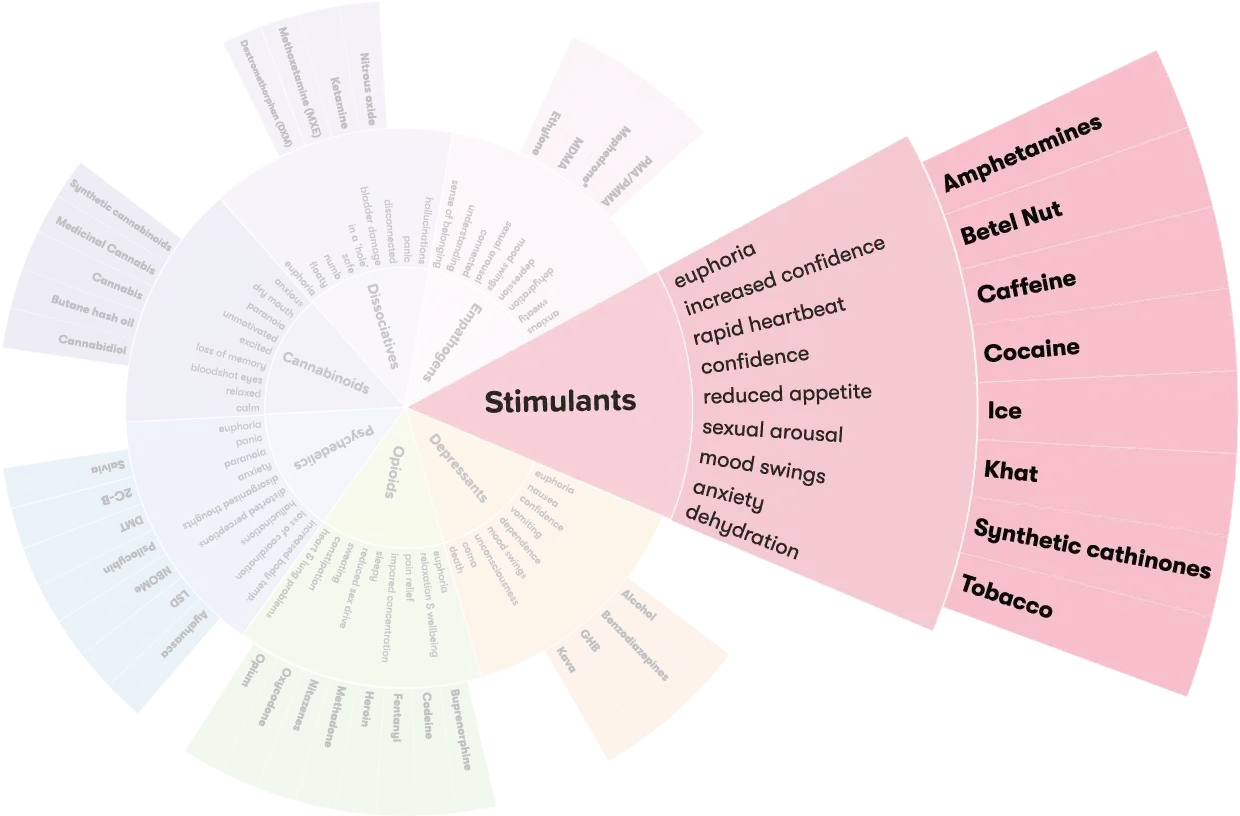Stimulants
Last published: March 07, 2025
What are stimulants?
Stimulants are a class of drugs that speed up messages travelling between the brain and body. They can make a person feel more awake, alert, confident or energetic.1
Stimulants include:
- legal substances such as caffeine and nicotine
- medications such as dexamphetamines, Adderall, methylphenidate (Ritalin)
- illicit substances such as speed, ice or cocaine.
What do stimulants look like?
Stimulants can be in the form of tablets, capsules, powders, and small chunky clear crystals or a white or brownish crystal-like powder with a strong smell and bitter taste.
Other names
Uppers, pep pills, speed
Commonly used stimulants
Explore stimulants on the Drug Wheel

How are stimulants used?
This will depend on the type of stimulant, but generally they can be taken orally (swallowed), chewed, snorted, smoked or injected. The onset of effects depends on what type of stimulant is taken and how it is taken.1,2
Effects of stimulants
Use of any drug can have risks. It’s important to be careful when taking any type of drug.
Stimulants affect everyone differently, based on:
- size, weight and health
- whether the person is used to taking it
- whether other drugs are taken around the same time
- the amount taken
- the environment (where the drug is taken)
- the type of stimulant taken – this will alter the effects significantly. For example, a regular dose of caffeine, or taking dexamphetamines medication as prescribed won’t have strong effects like ice or speed, and there is a much lower risk of harm.
For lower doses of stimulants, general effects might include:
- euphoria
- heightened feelings of wellbeing
- increased heart rate and blood pressure
- increased alertness
- talkativeness
- reduced appetite.1,2
Higher doses (particularly for illicit stimulants) may result in:
- anxiety
- tension
- increased body temperature
- nausea
- tremor
- seizures
- coma
- death.1,2
Impact of mood and environment
Drugs that affect a person’s mental state (psychoactive drugs) can also have varied effects depending on a person’s mood (often called the ‘set’) or the environment they are in (the ‘setting’):
- Set: a person’s state of mind, previous encounters with a drug, and expectations of what’s going to happen. For example, feelings of stress or anxiety before using certain drugs may result in an unpleasant experience and make those feelings worse.3
- Setting: the environment in which someone consumes a drug – whether it’s known and familiar, who they’re with, if they’re indoors or outdoors, the type of music and light. For example, using certain drugs in a calm, quiet and relaxed environment can lead to, or contribute to, a pleasant experience but being in a noisy, crowded place may result in a negative experience.3
Overdose
The risk of overdose is much higher when using illicit stimulants (e.g. ice, speed, cocaine). There is also an overdose risk with prescribed stimulants if the recommended dosage isn’t followed. Call an ambulance straight away by dialing triple zero (000) if you or someone else has any of the following symptoms (emergency services are there to help and can provide instructions over the phone):
- racing heartbeat
- chest pain
- breathing problems
- extreme agitation
- fits/convulsions
- passing out.1,4
Coming down
In the days after using certain stimulants, you may experience some unpleasant effects. For example, after using ice or speed you may experience difficulties sleeping.4,5 After using cocaine, you may feel some irritability and mild paranoia.6 You can check individual drug facts for their full list of comedown effects.
Tolerance and Dependence
Risk of tolerance and dependence will vary for the type of stimulant taken. People who use stimulants like ice, speed, cocaine and nicotine regularly can become dependent on them. They may feel they need the drug to go about their normal activities like working, studying and socialising, or just to get through the day. They may also develop a tolerance to it, which means they need to take larger amounts of the drug to get the same effect.
Dependence looks different when people are prescribed stimulants such as dexamphetamine or methylphenidate (Ritalin) to treat conditions such as ADHD or narcolepsy. People using these mediations may depend (or ‘rely’) on these medications to manage their underlying condition and support functioning. Risk of harm is more likely to occur with non-prescribed use (e.g. taking more than prescribed, taking incorrectly or mixing with other drugs).7
Mixing stimulants with other drugs
Mixing certain stimulants with other drugs can have unpredictable effects and increase the risk of harm:
- Ice/speed and MAOIs: elevated blood pressure, which can lead to irregular heartbeat, heart failure and stroke.8
- Cocaine/ice/speed and alcohol, opioids or benzodiazepines: the body is placed under a high degree of stress dealing with the conflicting effects of each drug, which can lead to an overdose.
- Ice and speed or cocaine: enormous strain on the heart and other parts of the body, which can lead to stroke.9
- Cocaine and MDMA: Cocaine blocks some of the desirable effects of MDMA while also increasing the risk of heart attack.10
More on Polydrug use
Polydrug use is a term for the use of more than one drug or type of drug at the same time or one after another. Polydrug use can involve both illicit drugs and legal substances, such as alcohol and medications.
Getting help
If your use of stimulants is affecting your health, family, relationships, work, school, financial or other life situations, or you’re concerned about someone else, you can find help and support.
Call the National Alcohol and Other Drug Hotline on 1800 250 015 for free and confidential advice, information and counselling about alcohol and other drugs
Help and Support Services search
Find a service in your local area from our list. Simply add your location or postcode and filter by service type to quickly discover help near you.
If you're looking for other information or support options, send us an email at druginfo@adf.org.au
Path2Help
Not sure what you are looking for?
Try our intuitive Path2Help tool and be matched with support information and services tailored to you.

- Brands B, Sproule B, Marshman J. Drugs and Drug Abuse. Toronto: Addiction Research Foundation; 1998 [08.05.2024].
- Farzam K Faizy R Saadabadi A. Stimulants 2022 [08.05.2024].
- Nutt D. Drugs without the hot air : making sense of legal and illegal drugs. Cambridge: UIT Cambridge Ltd; 2012 [08.05.2024].
- Campbell A. The Australian Illicit Drug Guide: Every Person's Guide to Illicit Drugs--Their Use, Effects and History, Treatment Options and Legal Penalties: Black Inc; 2001 [08.05.2024].
- Leonard W Dowsett G Slavin S Mitchell A & Pitts M. Crystal clear: the social determinants of gay men’s use of crystal methamphetamine in Victoria. Melbourne Australian Research Centre in Sex, Health & Society; 2008 [08.05.2024].
- Black E, Shakeshaft A, Newton N et al. Cocaine: what you need to know: National Drug and Alcohol Research Centre; 2017 [05.12.2023].
- Coghill D. The Benefits and Limitations of Stimulants in Treating ADHD. 2022 [08.05.2024]. In: New Discoveries in the Behavioral Neuroscience of Attention-Deficit Hyperactivity Disorder [Internet]. Cham: Springer International Publishing; [51-77].
- Vo K Neafsey P Lin C. Concurrent use of amphetamine stimulants and antidepressants by undergraduate students. Patient Preference and Adherence [Internet]. 2015 [08.05.2024]; 9.
- Australian Government Department of Health. Poly Drug Use What You Need To Know About Mixing Drugs 2014 [08.05.2024].
- hi-Ground. Cocaine [08.05.2024].
- Tucker JA, Darke, S, Lappin, J, Farrell, M.The Clinicians Guide to Illicit Drugs and Health: Silverback Publishing; 2019 [17.01.2024].
